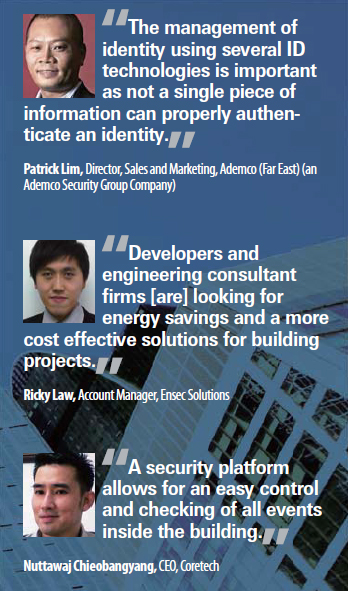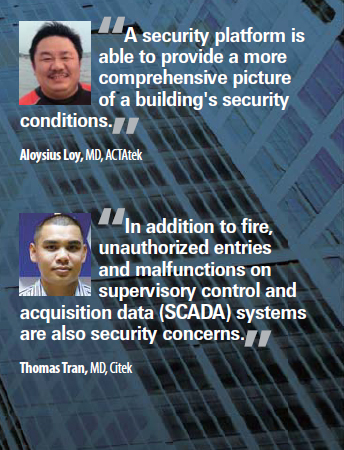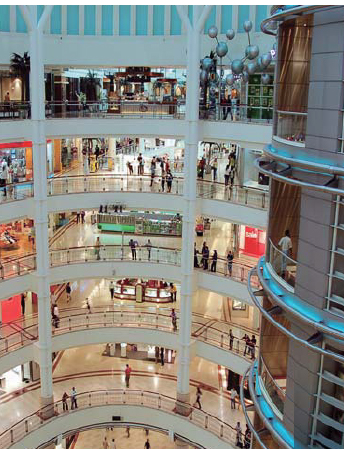Asia is devided in its economic performance. According to the World Bank, most Asian countries fall under the category of the developing world while a few have advanced into developed countries. This has led to different integrated solutions, in which building automation (BA) and security have become interwined with one another on different levels. This report examines how different commercial buildings can devise integratd security strategies based on their unique security demands.
In Asia, the commercial building market has relatively strong potential compared with other parts of the world as private funds, such as those in the U.S., have been showing great interest in the region in recent years. Some US private funds are either buying commercial properties in countries like Singapore or taking on new construction projects. Due to a great number of new constructions in Asia, the demand for integrated building automation (BA) systems are also on the rise.
INTEGRATED BA SOLUTIONS WITH SECURITY
In some developed economies like Singapore and Hong Kong, office buildings and financial buildings are common types of commercial structures. Office buildings can range from state-of-the-art skyscrapers housing regional headquarters of multinational corporations (MNCs) to mid-end buildings accommodating small and medium enterprises (SMEs). Financial buildings are those whose tenants are banks and financial institutions.
Office buildings used as regional head offices and financial buildings are the types that would resort to an integrated solution that bundles security and BA systems at the same time. As to the commercial building market in Asia, where building codes are not as clear as those in Europe or North America, what devices and functions should be included in an integrated system and how they should be done are largely dependent on the whims of building owners. But in general, the integrated BA solutions which highlight the improved energy efficiency and identity management is getting popular in these countries.
 Identity Management in High Demand
Identity Management in High Demand
The type of commercial buildings whose occupants are MNCs are required to protect physical and non-physical intellectual property, since the wealth of intellectual property, be it product prototypes, business letters, or customer information, can fall prey to break-ins and database infiltration. Moreover, the flow of of the outsourcing trend among some MNCs has caused a need for stringent security control. On the other hand, financial buildings that have safety deposit boxes, ATM machines, counters, and employee offices all within one construction also demand rigorous control as cash and client profiles require extra protection.
Therefore, a highly-integrated security solution focusing on identity management has become an answer to the protection of intellectual property, cash, and crucial client information. Identity management is an integrated solution that coordinates BA systems, security hardware, and oftentimes, biometric identification. Patrick Lim, Director of Sales and Marketing at Ademco (Far East) put it this way: “The management of identity using several ID technologies is important as not a single piece of information can properly authenticate an identity.”
What makes identity management so special in a highly-automated building is that as BA leaves the control of a building's access and other security matters to a computeroperated system, identity management, oftentimes with the help of biometrics, exerts a more humanized influence to the system.
Besides, identity management also works with a BA system to provide a customized environment for an individual. Lim took a CEO's office as an example. When a CEO steps into a building, the executive lift is already there waiting for him/ her and their office has been tuned to his/her preference upon arrival (e.g. the blinds are opened to allow in more sunshine).
 Energy Efficiency Becomes Unique Selling Point
Energy Efficiency Becomes Unique Selling Point
Both headquarters and financial buildings have added energy saving to in their integrated solutions. Ricky Law, Account Manager at Ensec Solutions, said lighting controls can go with access controls to achieve light saving functions, such as switching lights on and off with an access control card. Lighting controls can also be bundled with a building's heating, ventilation, and air conditioning (HVAC) systems for more energy savings.
New building projects in Asia's developed countries are also increasing demand for a highly automated security and energy saving systems. “Developers and engineering consultant firms [are] looking for energy saving and a more cost effective solution for building projects,” Law said, noting that the incorporation of more energy saving functions into an integrated automated security solution can be a selling point to new construction projects. In new constructions, energy saving functions like how lights and air conditioning systems should be controlled and preconfigured in the BA system have been considered in advance when buildings are under construction.
However, for SMEs, instead of occupying the whole or part of a commercial building, they are often only tenants of a floor or sometimes just a room. Energy saving “can be too rigid and creates inconvenience to tenants,” said Lim, referring to the complexity of integrating too many functions into existing building.
The re-modeling and re-deployment of pipes and wires in buildings can be a painstaking process, not to mention all SMEs in the building have to sit down, make negotiations, and reach agreements to get an integrated system done.
In addition, money is also an issue, Lim said. “The high cost of some of these systems can prevent smaller buildings and cost-sensitive organizations from adopting energy saving solutions,” he explained.
 SECURITY PLATFORM SECURES MULTIFUNCTIONAL BUILDINGS
SECURITY PLATFORM SECURES MULTIFUNCTIONAL BUILDINGS
Developing countries are investing heavily in their shopping centers and retail stores as it is the most efficient way to bring cash in. Building fancy malls and enticing tourists to buy have become a fast lane towards economic growth for countries like Thailand, which is a self-proclaimed “shopping paradise.” The shopping industry in Thailand is so strong that one of the country's mall developers, Central Pattana Pcl (CPN), is actually expanding its business to other parts of Southeast Asia and building shopping malls in Malaysia in 2016, followed by more shopping centers in Indonesia and Vietnam, according to Reuters.
The vibrant shopping industry in Thailand has brought in the demand for multifunctional buildings, where shopping centers occupy the first few floors while companies and other type of offices take up the upper layers of the building. The massive flow of shoppers downstairs and office workers upstairs have created a special demand for security.
The latest security solutions in multifunctional buildings in Thailand are adopting a security platform, close to the concept of physical security information management (PSIM), integrating all security data obtained from surveillance monitoring devices at all entrances and elevator doors, according to Nuttawaj Chieobangyang, CEO at Coretech Corporation, a security solution distributor in Thailand. This allows for “easy control and checking of all events inside the building.”
The security platform can grant different levels of control according to different layers of activities in the building. It can set a tighter control for company offices upstairs and less control to shopping centers downstairs. Aloysius Loy, MD at ACTAtek, a service provider of web-based security solutions, stressed that a security platform is able to provide a more comprehensive picture of a building's security conditions as the solution organizes all security equipment in the building, such as video surveillance systems, glass breaker detection, fire alarms and smoke detection, and temperature control systems, putting all information into a single platform and displaying it on a touch screen monitor.
FIRE PREVENTION MAIN CONCERN IN VIETNAM
As one of Asia's rising economies, Vietnam launched its economic reform in 1986 and has since enjoyed economic growth second to China. The Vietnam government's GDP growth rate surpassed 7 percent during the 1990s and was even able to register an over 5 percent growth between 2009 and 2012 when world economy slumped into recession, according to the World Bank. Also since the 1990s, more than 30,000 private businesses have been created.
The revitalized economic conditions of Vietnam have reflected on the construction of new buildings, including those for commercial purposes. The Vietnam Country Report 2012 showed that construction demand for office buildings surged to 493,000 square meters in 2010 from 245,000 square meters in 2008.
Mid-end office buildings are the major commercial building type in Vietnam. Unlike commercial buildings in other parts of Asia that place emphasis on intellectual property or unauthorized trespassing, buildings in Vietnam stress fire prevention, according to Thomas Tran, MD at Citek, manufacturer of surveillance equipment.
 Fire prevention is also the main theme of the building's integrated security solutions. Centered on fire alarms, a buildings' security system can combine with video surveillance, access control, and intrusion alerts, said Tran. Fire alarms can also be bundled with public address (PA) systems for evacuation purposes. “In addition to fire, unauthorized entries and malfunctions on supervisory control and acquisition data (SCADA) systems are also security concerns,” said Tran.
Fire prevention is also the main theme of the building's integrated security solutions. Centered on fire alarms, a buildings' security system can combine with video surveillance, access control, and intrusion alerts, said Tran. Fire alarms can also be bundled with public address (PA) systems for evacuation purposes. “In addition to fire, unauthorized entries and malfunctions on supervisory control and acquisition data (SCADA) systems are also security concerns,” said Tran.
Integrated Solutions Vary Based on Demand
Different types of commercial buildings have been presented in Asia based on business activities. Regional headquarters, financial buildings, and smaller office buildings housing tenants like SMEs have been particularly noticable in Singapore and Hong Kong.
Thailand's tourist-driven industry has led to the construction of multifunctional buildings that combine shopping centers and offices. Vietnam has initiated massive construction projects, including office buildings for the country's growing number of enterprises. Each type has different demands as to how its security can be done. Types of commercial buildings may vary, but further integration of all systems in a building is a foreseeable trend in the future in most parts of Asia.